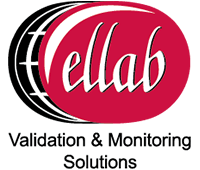Sponsored Content by EllabJan 15 2020
To protect patients against contagious diseases and infections, sterile and clean procedural and surgical hospital utensils is imperative. Therefore, central sterilization service departments (CSSDs) wash equipment in disinfectors before sterilizing them in large steam sterilizers known as autoclaves.
Most hospitals make use of large autoclaves (above 60L) and therefore are required to undertake daily steam penetration control tests to the standards ISO 17665 and EN 285. Tested daily to ensure patient safety, autoclaves must operate and sterilize as necessary. The Bowie Dick Test is the most frequently utilized steam penetration test.
Developed in 1963 by Dr. J. Bowie and J. Dick, the test is made up of a large volume of folded towels containing a sheet of paper equipped with chemical indicator tape and monitors air removal efficiency in steam sterilizers. The subsequent result would be considered a pass if the heated steam in the autoclave passes through the towels successfully and causes all of the tape to react.
The Bowie Dick test aims to assess if the air-removal system within the autoclave does as promised and removes any excess air and other non-condensable gasses (NCGs) successfully to ensure that saturated steam reaches and aptly sterilizes all parts of the equipment.
The original Bowie Dick test is still the reference technique for compliance testing of alternative Bowie Dick test techniques. The industry has come far since applying a large bundle of towels in their autoclaves, normally using contemporary electronic tests or traditional chemical indicators.

Image Credit: Ellab
Chemical Indicators
Chemical indicators, created with layers of paper and a special test sheet that changes color if the steam reaches it, have been utilized to establish whether the autoclave has reached saturated steam.
Indicator accuracy has come into question recently, as several studies have demonstrated false positives, which can jeopardize patient safety. Change in color is determined subjectively to signify a pass or fail. If read wrongly, a slight alteration in color can be detrimental.
Electronic Bowie Dick Tests
Electronic alternatives, which show routine batch control of autoclaves for daily testing, have been available for a while, due to the difficulties with chemical indicator storage. Electronic Bowie Dick tests assess the important physical parameters of the sterilization process, by showing more accuracy.

Image Credit: Ellab
Batch Control and Parametric Release
Batch control proves that loads are sterilized in compliance with the Safety Assurance Level (SAL). Daily routine control of autoclaves, on the other hand, is performed to “release” autoclaves early in the day. Traditionally, biological indicators have been the most used technique for batch control of steam sterilizers.
Electronic test units have now been introduced to carry out fast and efficient batch controls. The ampule indicators contain a certain amount of microbiological spores in suspension, which are counted after sterilization over a long period to classify the survival rate.
Giving instant results and permitting parametric release, a principle that requires measured data of critical physical parameters using an independent electronic device, these devices are introduced alongside the batch and read post sterilization.
Compared to traditional indicators and techniques, electronic devices and the parametric release techniques carry some distinct benefits. This includes:
- Data is shown with a clear pass/fail result, removing any subjective assessment and the risk of misreading
- Electronic devices being economically efficient with high test volumes, meaning data is easily stored, retrieved and compared as it is all located conveniently in a database for safe operation,
- Electronic solutions lead to fewer waste products, providing a more environmentally friendly process, and the result is presented straight after the test, permitting the batch/load to be released immediately. Meanwhile, biological indicators need to be incubated and require resource-dependent assessments before a batch/load is released.
Choosing the Ultimate Electronic Bowie Dick Test Device
Ellab recently launched the ISO 11140-4 compliant SteriSense®, an innovative product for electronic Bowie Dick testing and batch control, an unrivalled user-friendly system size-wise, in performance, accuracy, and reliability.
The compact device maintains patient safety by highlighting potentially faulty sterilizers that could have passed less reliable methods. With annual calibrations, the SteriSense sensors stay highly accurate all year round.
Game-changing, the SteriSense has an interchangeable process challenge device (PCD), meaning that operators do not have to purchase additional backup devices for subsequent runs, or wait for equipment to cool. Rather, they can unscrew the PCD and replace it with a spare before running another cycle.
Little training is required to use SteriSense, with the measuring unit ready to be placed in the process with one simple click. Once complete, the device is read, assessing the data straight away and providing a clear pass or fail result. A report may be produced, assessed and saved, if more detail is required, ensuring full electronic documentation.

Image Credit: Ellab
About Ellab
Ellab Validation & Monitoring Solutions - Industry Leading Accuracy
Ellab has been your validation and monitoring partner since 1949, offering wireless data loggers and thermocouple systems for thermal validation processes as well as environmental wireless monitoring solutions.
We serve both small and large companies within the Life Science and Food industries and have solutions for almost all applications such as sterilization, freeze drying, environmental chamber testing, depyrogenation, warehouse mapping, pasteurization and many more.
In 2019 we joined forces with Hanwell Solutions Ltd. in UK in order to expand our product offering to cover industry leading wireless environmental monitoring systems.
Sponsored Content Policy: News-Medical.net publishes articles and related content that may be derived from sources where we have existing commercial relationships, provided such content adds value to the core editorial ethos of News-Medical.Net which is to educate and inform site visitors interested in medical research, science, medical devices and treatments.